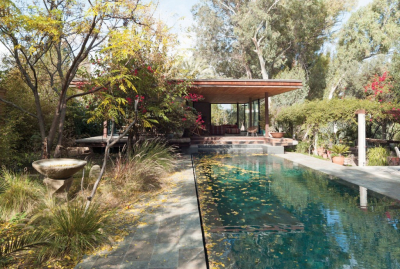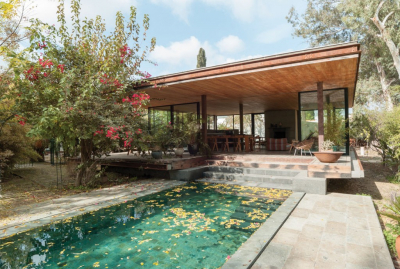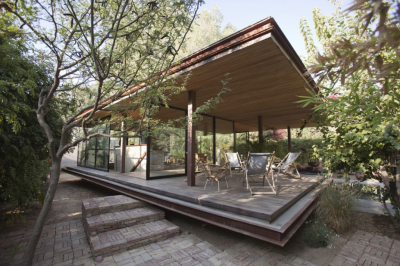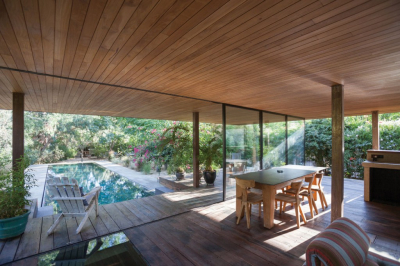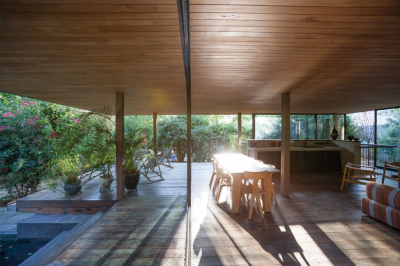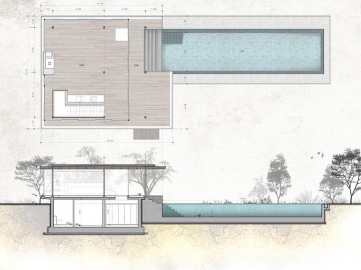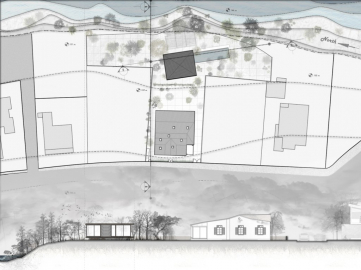Pavilion at Architect's Residence
Completed in 2013, the pavilion is situated in a 2000 square meter plot of land, along the Pedieos river, in the Ayios Andreas district of the city of Nicosia, Cyprus, and is designed to co-exist with a refurbished 1940s listed house.
The T shaped site enjoys an 80 meter long exposure to the river, on the east, along which, the garden gently slopes down to meet the river bank and merge with its natural habitat, thus blurring the boundary between the man made and the natural. It is at this junction between the man-made and the natural that the pavilion is positioned, right on the riverside, in contrast to the listed house, found at the street end, responding to the suburban character of the area. First conceived in 2010, to function as a nature retreat and guesthouse, the pavilion, with every one of its physical elements distilled to their irreducible essence, represents a minimalist expression of architecture, gently placed within the complementary and concurrently contradicting context of an informally landscaped garden and a spontaneous nature, creating a pure harmonic balance between the man made geometric form, and the organic landscape surrounding it, a landscape, which becomes an integral aspect of the architects aesthetic and architectonic conception. Spatially, it consists of a 9 by 11 ( 99 m² ) meter, semi-basement exposed concrete space, containing a bedroom, bathroom, seating room and a kitchen, acting as a self sustained guest house, and a 12 by 11 ( 132 m² ) meter, open plan, elevated pavilion space. The Pavilion is composed of two horizontal elements, the floor plane, a concrete slab, floating 80 centimeters above the ground, clad with 3 centimetre thick reclaimed hardwood planks, and the ceiling plane, a metal decking / light concrete slab, clad with tongue and groove teakwood strips. With its emphatically planar floors and roof suspended on the widely spaced, steel columns, the space appears to float above the ground, with three wide, red brick steps, transcending almost effortlessly off the ground paving, as if they were floating up to the entrance.
In-between the two floating wooden planes, 2,5 meter high floor to ceiling glazed sliding glass walls, empower the architects idea of tying the space with its surroundings while redefining the character of the boundary between shelter and that which is outside. The glazing, works together dialectically, shifting the viewers awareness between the thrill of exposure to the raw elements of nature when open, and the comforting stability of an architectonic enclosure when closed. A series of lively reflections of the surrounding landscape, create an infinite layering of ever changing images and experiences.
The pavilion structure is mainly a steel post and beam structure supported on the structural slab which is the semi-basement ceiling slab. It consists of eight square shaped corroded steel columns contrasting with the lighter trunks of the surrounding eucalyptus trees but also complementing the natural colors through their natural patina, and a hammered concrete structural wall, disguised as a fireplace, that acts as an anti seismic wall. On the North, East and West facades the glass walls are flat with no overhang in order to let the morning and afternoon sun in, and maximize the visibility to the sky, while on the south side of the pavilion, the roof structure / wooden ceiling extends beyond the sliding glass walls and acts as a cover to an elevated verandah space, an extension of the inside, on the right, and to the slow steps leading directly into the green andesite stone tiled overflow pool on the left.

